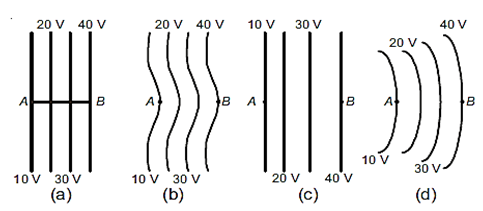 Multiple Choice Questions
Multiple Choice QuestionsWater falls from a height of 60 m at the rate of 15 kg /s to operate a turbine. The losses due to frictional
8.1 kW
10.2 kW
12.3 kW
12.3 kW
A tube of length L is filled completely with an incompressible liquid of mass M and closed at both the ends. The tube is then rotated in a horizontal plane about one of its ends with a uniform angular velocity ω. The force exerted by the liquid at the other end is




The diagrams below show regions of equipotentials
A positive charge is moved from A to B in each diagram.
Maximum work is required to move q in figure (c).
In all the four cases the work done is the same.
Minimum work is required to move q in figure (a).
Minimum work is required to move q in figure (a).
Consider a drop of rain water having mass 1 g falling from a height of 1 km. It hits the ground with a speed of 50 m/s. Take g constant with a value 10 m/s2. The work done by the (i) gravitational force and the (ii) resistive force of air is
(i) – 10 J (ii) –8.25 J
(i) 1.25 J (ii) –8.25 J
(i) 100 J (ii) 8.75 J
(i) 100 J (ii) 8.75 J
100J
50J
200J
75J
A.
100J
The work done in pulling up a block of wood weighing 2 kN for a length of 10 m on a smooth plane inclined at an angle of 15° with the horizontal is
9.82 kJ
89 kJ
4.35 kJ
5.17 kJ
If the heat of 110 J is added to a gaseous system, whose internal energy is 40 J, then the amount of external work done is
180J
70J
110J
30J
The spring extends by x on loading, then energy stored by the spring is (if T is the tension in spring and k is
spring constant
